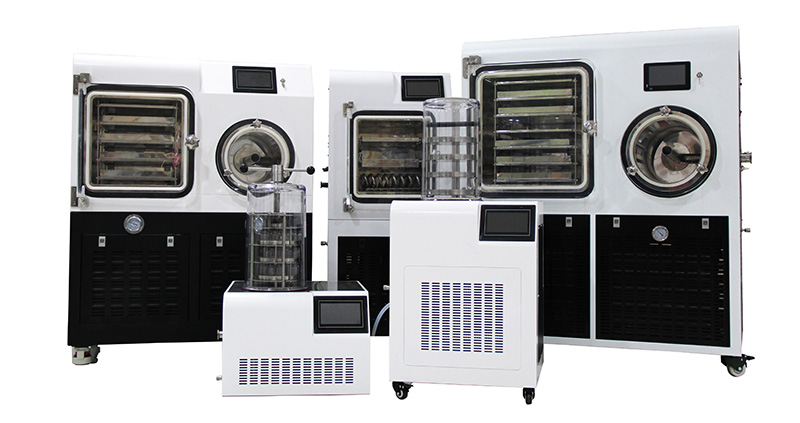The freeze-drying principle of Shanghai Yetuo freeze-drying machine:
Freeze drying technology is a special drying technique, and the basic principle of freeze drying technology is based on the three-phase change of water. The three phases of water (H2O) are solid, liquid, and gas, and the three phases of water can coexist or convert to each other.
Firstly, it is freezing. When the solution is rapidly frozen (cooling by 10-50 ℃ per minute), the grain size remains visible under the microscope; On the contrary, the crystals formed during slow freezing (1 ℃/min) are visible to the naked eye. Coarse crystals leave large gaps during sublimation, which can improve the efficiency of freeze-drying. Fine crystals leave smaller gaps after sublimation, which hinders the sublimation of the lower layer. The finished product of rapid freezing has fine particles, uniform appearance, large specific surface area, good porous structure, fast dissolution rate, and relatively stronger moisture absorption of the finished product. The drugs are pre frozen in two ways in the freeze-drying machine: one is to cool the product and drying oven simultaneously; Another method is to wait for the drying oven shelf to cool down to around -40 ℃ before placing the products. The former is equivalent to slow freezing, while the latter is between quick freezing and slow freezing, and is often used to balance freeze-drying efficiency and product quality. The disadvantage of this method is that when the product is put into the box, the water vapor in the air will quickly condense on the shelf. In the early stage of sublimation, if the plate heats up quickly, the large area of sublimation may exceed the normal load of the condenser. This phenomenon is particularly significant in summer. The freezing of the product is in a static state. Experience has shown that supercooling can easily occur to the point where the product temperature has reached the eutectic point. But the solute still does not crystallize. In order to overcome the supercooling phenomenon, the temperature at which the product freezes should be lower than a range below the eutectic point and should be maintained for a period of time until the product is completely frozen.
Another factor is the conditions and speed of sublimation. When the saturated vapor pressure of ice at a certain temperature is greater than the partial pressure of water vapor in the environment, sublimation can begin; The suction and capture of water vapor by a condenser with a lower temperature than the product is a necessary condition for maintaining the temperature rise. The distance traveled by gas molecules between two consecutive collisions is called the mean free path, which is inversely proportional to pressure. At normal pressure, its value is very small, and the sublimated water molecules are prone to collide with the gas and return to the surface of the steam source, resulting in a slow sublimation rate. As the pressure decreases below 13.3 Pa, the average free path increases by 105 times, significantly accelerating the sublimation rate. The water molecules that fly out rarely change their orientation, thus forming a directed steam flow. The vacuum pump plays a role in removing permanent gases in the freeze dryer to maintain the necessary low pressure for sublimation. At atmospheric pressure, 1g of water vapor is 1.25L, but at 13.3Pa, it expands to 10000 liters. It is impossible for a regular vacuum pump to extract such a large volume per unit time. The condenser actually forms a vacuum pump specifically designed to capture water vapor. The temperature for product and condensation is usually -25 ℃ and -50 ℃. The saturated vapor pressures of ice at this temperature are 63.3 Pa and 1.1 Pa, respectively, resulting in a significant pressure difference between the sublimation and condensation surfaces. If the partial pressure of non condensable gases in the system can be ignored at this time, it will cause the water vapor sublimated from the product to reach the condenser surface at a certain flow rate and form frost. The sublimation heat of ice is about 2822J/gram. If no heat is supplied during the sublimation process, the product can only compensate for the sublimation heat by reducing its internal energy until its temperature reaches equilibrium with the condenser temperature, and the sublimation stops. In order to maintain the temperature difference between sublimation and condensation, sufficient heat must be provided to the product.
Entering the sublimation process, in the first stage of heating (extensive sublimation stage), the temperature of the product should be within a range below its eutectic point. Therefore, the shelf temperature needs to be controlled. If the product has been partially dried but the temperature exceeds its eutectic point, the product will melt, and the melted liquid will be saturated with ice but not saturated with solute. Therefore, the dried solute will quickly dissolve and eventually condense into a thin and stiff block, with an extremely poor appearance and slow dissolution rate. If the melting of the product occurs in the later stage of extensive sublimation, due to the small amount of melted liquid, it will be absorbed by the dried porous solid, causing damage to the block after freeze-drying. When dissolved with water, the dissolution rate can still be slow. In the process of extensive sublimation, although there is a significant temperature difference between the shelf and the product, the sublimation heat absorption is relatively stable and the product temperature is relatively constant due to the fact that the plate temperature, condenser temperature, and vacuum temperature remain basically unchanged. As the product dries layer by layer from top to bottom, the resistance to ice sublimation gradually increases. The temperature of the product will also slightly increase accordingly. Until the presence of ice crystals is no longer visible to the naked eye. At this point, over 90% of the moisture has been removed. The process of extensive sublimation has basically come to an end. In order to ensure that the entire box of products is fully sublimated, the plate temperature still needs to be maintained for one stage before the second stage of heating is carried out. The remaining percentage of water is called residual water, which differs in physical and chemical properties from free state water. Residual water includes chemically bound water and physically bound water, such as crystallized water, water bound by proteins through hydrogen bonds, and adsorbed water on solid surfaces or capillaries. Due to the binding of residual moisture by a certain gravity, its saturated vapor pressure decreases to varying degrees, resulting in a significant decrease in drying speed. Although increasing the temperature of the product promotes the gasification of residual moisture, if the temperature exceeds a certain limit, the biological activity may also sharply decrease. The maximum drying temperature required to ensure product safety should be determined through experimentation. Usually, in the second stage, we maintain a plate temperature of around+30 ℃ and keep it constant. At the beginning of this stage, due to the increase in plate temperature, there is less residual moisture and it is not easy to vaporize, so the temperature of the product rises rapidly. But as the temperature of the product gradually approaches the temperature of the board, heat conduction becomes slower and requires patience for a considerable period of time. Practical experience has shown that the drying time for residual moisture is almost equal to the time for a large amount of sublimation, and sometimes even exceeds it.
Finally, record the changes in shelf temperature and product temperature over time to obtain the freeze-drying curve. A typical freeze-drying curve system divides the temperature rise of the shelf into two stages. During a large amount of sublimation, the temperature of the shelf remains low, and can generally be controlled between -10 and+10 depending on the actual situation. In the second stage, the shelf temperature is adjusted appropriately according to the properties of the product, which is suitable for products with lower melting points. If the performance of the product is not yet clear, the machine performance is poor, or its operation is not stable enough, this method is also more reliable. If the eutectic point of the product is high, the vacuum degree of the system can be maintained well, and the refrigeration capacity of the condenser is sufficient, a certain heating rate can also be used to raise the shelf temperature to the maximum allowable temperature until the freeze-drying is completed, but it is also necessary to ensure that the temperature of the product during mass sublimation does not exceed the eutectic point. If the product is thermally unstable, the second stage plate temperature should not be too high. In order to improve the sublimation speed of the first stage, the shelf temperature can be raised once to above the maximum temperature allowed by the product; When the stage of extensive sublimation is basically over, the plate temperature should be lowered to the maximum allowable temperature. Although these latter two methods increase the speed of extensive sublimation to some extent, their anti-interference ability is correspondingly reduced. Sudden decrease in vacuum degree and cooling capacity or power outage may cause the product to melt. Reasonably and flexibly mastering the first method is still a commonly used approach at present.
When the water vapor pressure is greater than 6.105 × 10-4MPa, ice will melt into water, which will then evaporate into water vapor, known as the evaporation process; When the water vapor pressure is less than 6.105 × 10-4MPa, ice is heated and sublimated into water vapor, which is the sublimation process. The vacuum freeze dryer utilizes the principle of phase change of water. Freeze drying is the process of pre cooling materials to -30~-40 ℃, which can freeze most of the moisture in the materials into ice and provide a low-temperature heat source. Under vacuum conditions, the ice is sublimated into water vapor, thereby achieving the purpose of dehydration and drying of the materials.
The products obtained by ordinary drying generally have problems of volume reduction and texture hardening. Most of the volatile components are lost, and some heat sensitive substances undergo denaturation and deactivation. Some substances even undergo oxidation. There are significant differences in traits. Because the vacuum freeze-drying machine is different from traditional heating methods, heating drying only undergoes one phase transition from "liquid to gas", while freeze-drying requires two phase transitions, first from "liquid to solid" deformation, and then through sublimation "solid to gas" phase transition. Therefore, materials treated with freeze-drying technology have a porous and loose structure, which has better rehydration properties and is convenient for subsequent processing or direct consumption.
Moreover, freeze-drying machines have a wide range of applications, and all non-toxic and moisture containing items can use freeze-drying technology, which is applied in various fields such as medicine, biological products, food, active substances, etc. Its application scale is still rapidly expanding.


 Alibaba Store
Alibaba Store Tmall Store
Tmall Store Jingdong Sstore
Jingdong Sstore







